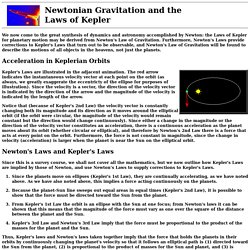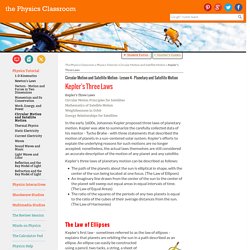

Earth’s Orbit Around The Sun. Diagram of the Earths orbit around the Sun.

Credit: NASA/H. Zell Ever since the 16th century when Nicolaus Copernicus demonstrated that the Earth revolved around in the Sun, scientists have worked tirelessly to understand the relationship in mathematical terms. If this bright celestial body – upon which depends the seasons, the diurnal cycle, and all life on Earth – does not revolve around us, then what exactly is the nature of our orbit around it? For several centuries, astronomers have applied the scientific method to answer this question, and have determined that the Earth’s orbit around the Sun has many fascinating characteristics.
First of all, the speed of the Earth’s orbit around the Sun is 108,000 km/h, which means that our planet travels 940 million km during a single orbit. Newtonian Gravitation and the Laws of Kepler. Newtonian Gravitation and theLaws of Kepler We now come to the great synthesis of dynamics and astronomy accomplished by Newton: the Laws of Kepler for planetary motion may be derived from Newton's Law of Gravitation.

Furthermore, Newton's Laws provide corrections to Kepler's Laws that turn out to be observable, and Newton's Law of Gravitation will be found to describe the motions of all objects in the heavens, not just the planets. Acceleration in Keplerian Orbits. Perihelion, Aphelion and the Solstices. The Earth is closest to the Sun or at its Perihelion two weeks after the December solstice and farthest from the Sun or Aphelion, two weeks after the June Solstice.

In 2015, the Earth will reach its Aphelion at 19:41 (7:41 pm) UTC on July 6, 2015. This is 15 days after the June Solstice. The Earth reached its Perihelion at 6:37 am UTC on January 4, 2015, 14 days after the 2014 December Solstice. Aphelion event in your local time. Kepler's Three Laws. In the early 1600s, Johannes Kepler proposed three laws of planetary motion.

Kepler was able to summarize the carefully collected data of his mentor - Tycho Brahe - with three statements that described the motion of planets in a sun-centered solar system. Kepler's efforts to explain the underlying reasons for such motions are no longer accepted; nonetheless, the actual laws themselves are still considered an accurate description of the motion of any planet and any satellite. GCSE Bitesize: The solar system. History and Philosophy of Western Astronomy. Chapter index in this window — — Chapter index in separate window This material (including images) is copyrighted!.

See my copyright notice for fair use practices. Select the photographs to display the original source in another window. Johaness Kepler (lived 1571--1630 C.E.) was hired by Tycho Brahe to work out the mathematical details of Tycho's version of the geocentric universe. Kepler was a religious individualist. Since an infinite number of models are possible (see Plato's Instrumentalism above), he had to choose one as a starting point. Kepler tried to refine Copernicus' model. An ellipse is a squashed circle that can be drawn by punching two thumb tacks into some paper, looping a string around the tacks, stretching the string with a pencil, and moving the pencil around the tacks while keeping the string taut.
There are some terms I will use frequently in the rest of this book that are used in discussing any sort of orbit. History and Philosophy of Western Astronomy. S-cool, the revision website. The Solar System is made up of the nine planets, including the Earth, that orbit (go round) the Sun.

See whether you can name them on the diagram below: The four inner planets are called terrestrial planets and are small rocky planets. Between Mars and Jupiter, there is an asteroid belt, which may be the remains of a planet. The next four are called gas giants and are large planets made up of gas.
Pluto is a very cold lump of rock, with a moon - Charon - nearly as large as Pluto. Decide whether the following facts are true or false: The moon orbits the earth in 28 days and the Earth orbits the sun in 365¼ days. As mentioned above, the planets move in near circular orbits called ellipses. Objects will only move in a circle if there is a force acting on them.
But why must there be a force for objects to travel in a circle? Speed and velocity Velocity is speed with direction. GCSE Science: GCSE Physics - our solar system. Our Solar System consists of the Sun with planets in orbit around it.

Most planets have at least one satellite (moon) in orbit around them. Gravity provides the centripetal force needed to keep objects in orbit. We can explore space using manned or unmanned spacecraft. GCSE SCIENCE PHYSICS HIGH SCHOOL - The Planets - Orbit and Gravity - gcsescience.com. GCSE Bitesize: The solar system.